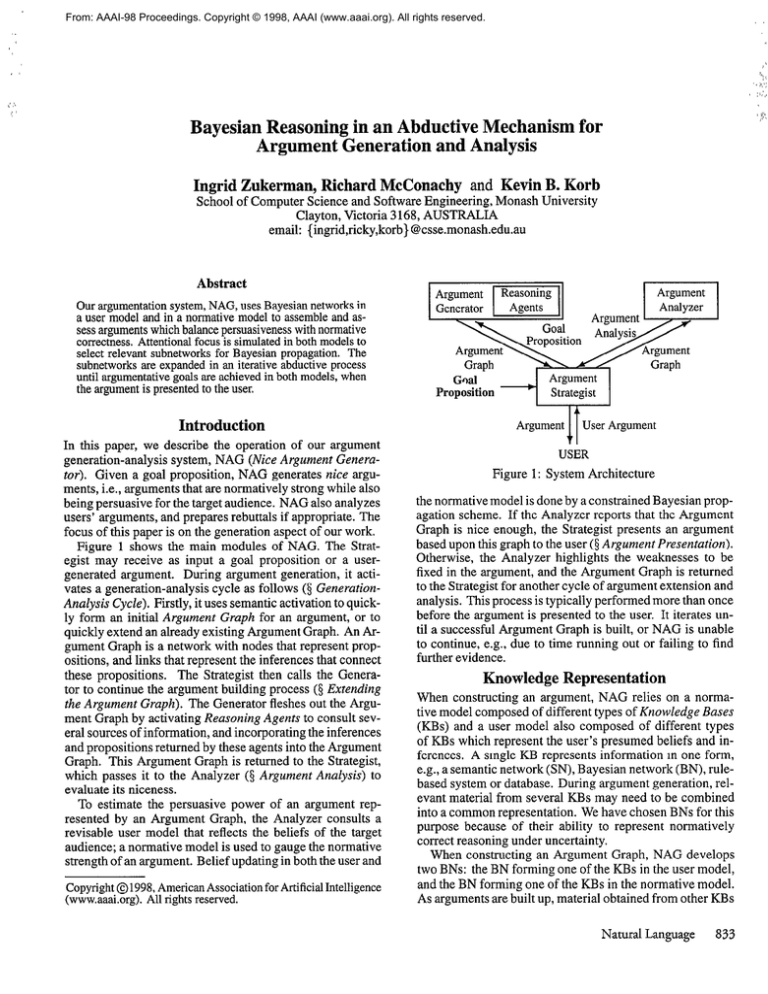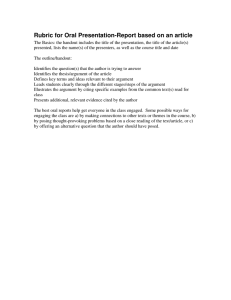
From: AAAI-98 Proceedings. Copyright © 1998, AAAI (www.aaai.org). All rights reserved.
Bayesian Reasoning in an Abductive Mechanism for
Argument Generation and Analysis
Ingrid Zukerman, Richard McConachy and Kevin B. Korb
School of ComputerScienceand SoftwareEngineering,Monash University
Clayton, Victoria 3168, AUSTRALIA
email: {ingrid,ricky,korb} @csse.monash.edu.au
Abstract
Our argumentation
system,NAG, usesBayesiannetworksin
a usermodelandin a normativemodelto assemble
andassessarguments
whichbalancepersuasiveness
with normative
correctness.
Attentionalfocusis simulatedin bothmodelsto
selectrelevantsubnetworks
for Bayesianpropagation.The
subnetworks
areexpandedin an iterativeabductiveprocess
until argumentative
goalsareachievedin bothmodels,when
theargumentis presented
to theuser.
Introduction
In this paper, we describe the operation of our argument
generation-analysissystem, NAG (Nice Argument Generator). Given a goal proposition, NAG generatesnice arguments,i.e., argumentsthat arenormatively strongwhile also
being persuasivefor the targetaudience.NAG also analyzes
users’arguments,and preparesrebuttalsif appropriate.The
focus of this paperis on the generationaspectof our work.
Figure 1 shows the main modules of NAG. The Strategist may receive as input a goal proposition or a usergeneratedargument. During argumentgeneration,it activates a generation-analysiscycle as follows (5 GenerutionAnalysis Cycle). Firstly, it usessemanticactivationto quickly form an initial Argument Graph for an argument,or to
quickly extendan alreadyexisting ArgumentGraph. An Argument Graph is a network with nodesthat representpropositions, and links that representthe inferencesthat connect
these propositions. The Strategist then calls the Generator to continue the argumentbuilding process(5 Extending
the Argument Graph). The Generatorfleshesout the Argument Graph by activating Reasoning Agents to consult several sourcesof information, and incorporatingthe inferences
and propositionsreturnedby theseagentsinto the Argument
Graph. This Argument Graph is returnedto the Strategist,
which passesit to the Analyzer (5 Argument Analysis) to
evaluateits niceness.
To estimate the persuasivepower of an argumentrepresentedby an Argument Graph, the Analyzer consults a
revisable user model that reflects the beliefs of the target
audience;a normativemodel is usedto gaugethe normative
strengthof an argument.Belief updatingin both the userand
Copyright01998, AmericanAssociation
for ArtificialIntelligence
(www.aaai.org).
All rightsreserved.
Goal
Proposition-
Argument
Strategist
Argument UserArgument
USER
Figure 1: SystemArchitecture
the normativemodel is doneby a constrainedBayesianpropagation scheme. If the Analyzer reports that the Argument
Graph is nice enough, the Strategistpresentsan argument
basedupon this graphto the user(5 Argument Presentation).
Otherwise, the Analyzer highlights the weaknessesto be
fixed in the argument,and the Argument Graph is returned
to the Strategistfor anothercycle of argumentextensionand
analysis.This processis typically performedmore than once
before the argumentis presentedto the user. It iteratesuntil a successfulArgument Graph is built, or NAG is unable
to continue, e.g., due to time running out or failing to find
further evidence.
Knowledge Representation
When constructing an argument,NAG relies on a normative model composedof different types of Knowledge Bases
(KBs) and a user model also composedof different types
of KBs which representthe user’s presumedbeliefs and inferences. A smgle KB representsinformation in one form,
e.g.,a semanticnetwork (SN), Bayesiannetwork (BN), rulebasedsystemor database.During argumentgeneration,relevant material from severalKBs may need to be combined
into a commonrepresentation.We have chosenBNs for this
purpose becauseof their ability to represent normatively
correct reasoningunder uncertainty.
When constructing an Argument Graph, NAG develops
two BNs: the BN forming one of the KBs in the user model,
andthe BN forming one of the KBs in the normativemodel.
As argumentsarebuilt up, material obtainedfrom other KBs
Natural Language 833
may be converted to BN form and added to the appropriate
BN, e.g., material from a rule-basedsystemin the user model
may be added to the user model BN (5 Extending the Argument Graph). To reduce the amount of information NAG
must deal with, we apply a focusing mechanismwhich highlights the portion of the complete BN in each model that is
neededfor the current argument (5 Focusing the Argument).
Hence, each of the user model and the normative model
contains a single Bayesian subnetwork that is in focus. The
structural intersection of these Bayesian subnetworksforms
the Argument Graph. When analyzing this graph, propagation is performed twice, once over the Bayesian subnetwork
in the user model and once over the Bayesian subnetwork
in the normative model, each time using probabilistic information sourced from within the model being propagated
(5 Argument AnaZysis). Thus, wemeasure the strengthof the
sameargument in the user model and the normative model.
Generation-Analysis Cycle
m~ntinnml
IIIVI,LI”,I”U
in
111 u3 nrw,mhl~
r’“u”‘“”
tn
m-onm,=nt
CY th,a
LI‘” .+L@u”.-“
’
nl,,r
y-u”
the argument’s goal; this context is expanded as the Argument Graph grows. The degreesof belief to be achieved are
expressedas ranges of probabilities, e.g., [OS, 0.61,in order
to be able to representa variety of goals, e.g., inducing doubt
when a strong belief is inappropriate.
Upon completion of the argumentationprocess,the Strategist producesan Argument Graph which startsfrom admissible premises and ends in the goal proposition. Admissible
premises are propositions that start out being believed by
NAG and the user (sufficiently for the argumentto work).
The Strategist executesthe following algorithm during argument generation. In principle, this procedureis applicable
to any proposition, and hence also to special forms such as
promises and modal propositions. However, it does not currently have facilities to treat these forms in any special way.
Generation-Analysis
Algorithm
1. ito.
2. Clamp any items in the current context, contexti, and
perform spreading activation. This yields an Argument
Graph containing: the clamped nodes,the activated nodes
(whose activation exceedsa threshold), plus the links connecting these nodes (5 Focusing the Argument).
3. Identify new subgoals in the current Argument Graph
(3 Choosing Argument Subgoals).
4. Pass the argument subgoals identified in Step 3 to the
C-L..m.d~\t
UUInALIC”I,
.x,h;,.h
WIIIti,.
oAAr
auua
tha
L.‘b no,,,
,I”“”
;nfm.mot;nn
,,ll”llllcLLl”ll
rpt,,rnc.A
lUIUlll”U
hx,
“J ;+c
I,0
ReasoningAgents to the current Argument Graph (5 Extending the Argument Graph).
5. Passthe Argument Graph generatedin Step 4 to the Analyzer for evaluation (§ Argument Analysis).
6. If the Analyzer reports that the current Argument Graph is
sufficiently nice, then present an argument based on this
834
Argumentation
Propositions,e g , [widespread indlum was deposited 65 mil yr BC]
Figure 2: Sample Semantic-BayesianNetwork
graph to the user, and wait for a response (5 Argument
Presentation). Otherwise, continue.
7. i t i + 1.
NAG receives the following inputs: (1) a proposition to be
arguedfor; (2) an initial argumentcontext; and (3) two target
ranges of degreesof belief to be achieved (one each for the
normative model and the user model). The initial argument
context, denoted contexto, is composed of the propositions
onrl
LII‘U ~nn,.ran+r
““IIuvyco
Lower level
t context,-1 + new nodes connected to the
goal during cycle i-l.
9. Go to Step 2.
When receiving a user’s argument,an analysis-generation
cycle is activated. This cycle begins in Step 5, which results in the acceptanceof the user’s argument if no flaws are
detected. Otherwise, the cycle is completed, and the generation part of the cycle is performed (Steps 2, 3 and 4) to
try to bridge small inferential gaps in the user’s argument.
This cycle is repeatedonly a few times, since large gaps in a
user’s argumentmake it more likely that NAG and the user
are using different lines of reasoning.
8. contexti
Focusing the Argument
Bayesian network propagation (Pearl 1988) is an NP-hard
problem in the general case (Cooper 1990). NAG is designed to be an interactive system, potentially drawing upon
very large knowledge bases,so complete propagation over
large BNs is not feasible. In addition, NAG’s user model
is designedto model human cognitive abilities, and humans
normally cannot absorb and analyze all data relevant to a
complex problem. To cope with both of theselimits on complexity we emulate the principal meansavailable to humans
for applying limited cognitive capacity to problem solvmg,
namely attention (see,for example, Baars 1987).
NAG uses two hierarchical SNs, one built on top of the
user model BN and one built on top of the normative model
BN, to capture associativeconnectionsbetween information
items (Figure 2 illustrates a semantic-Bayesian network).
The initial semantic-Bayesiannetworks are currently built
manually, but they may be automatically extendedduring argument generation(5 Extending the Argument Graph). Both
rLPbTauu
..-A rl_l3hTtuG
--^ ._^_
1 L-.
XT*0 4^
-: -..,- *_ ilLLGl,L,“LI,.rr^-L-..
UK 31Y
UK DIY
LlbCU
uy IYAU
L”511111115111;
al focus in each model. However, the resulting Argument
Graph contains only propositions and links from the BN.
NAG takes the context in which the argument occurs as
providing an initial set of salient objects. For example, if the
user presents an argument to NAG, the concepts occurring
in the propositions within the argument or in the preceding
N7
addition to the clampednodes.The links betweenthe nodes
in Figure 3 were obtainedfrom the BNs. However, the activation of thesenodesinvolved spreadingactivation through
the BNs and the SNs. Additional nodes, such as [California has fault-lines] (not shown in Figure 3) were activated
via the SNs. However, if no causal or evidential links are
found betweensuch nodesand the goal, they are eventually
,.“,.l..A,.AA-‘
A”.%..-,..+rL.....L
GALalUUGU
II”lll.- +I.,
u10rll~UI11G111
“lap.
ChoosingArgument Subgoals
Figure 3: Initial Argument Graphfor the Asteroid Example
discussionwill be markedas salient. We useactivationwith
decay (Anderson 1983), spreadingfrom the salient objects
(which are clamped) to determine the focus of attention.
All items in the semantic-Bayesiannetworkswhich achieve
a threshold activation level during the spreadingactivation
processare brought into the spanof attention. This process
passesactivation through the semantic-Bayesiannetworks,
eachnode being activatedto the degreeimplied by the activation levels of its neighbors,the strengthof associationto
those neighbors,and its immediately prior activation level
(vitiated by a time-decayfactor). By thesemeanswe havea
direct implementationof attention which we use to zero-in
..^^_
^_.^
-A.--A:--^
^----r:- T3^_.^^:-qJ”I’ rl-UK -^-IIIVIE:-..I
ICl‘
cYkillL
pu1Ll”‘lS “I-CrLwe SelnallUL-Dayeslan
networks. This iterative processceaseswhen an activation
cycle fails to activatea new node.
Determining the more relevant portions of the semanticBayesian networks in this way allows NAG to save processingtime in two ways: NAG restrictsitself to searching
for information connectedwith the propositions in focus
(5 ChoosingArgument Subgoals),ratherthan all of the propositions known to it; and NAG analyzesits argumentswith
respectto just the samepropositionsin focus, saving time
during Bayesianpropagation(3 Argument Analysis).
---..--,-‘:-. or
-cr.dn argu..._~.
n----!-- - - nxdmple.
n-.,----l - “-..-:J-..rl-r oLusmg
Lvnsiuer me generation
ment for the proposition“A largeiridium-rich asteroid struck
Earth about65million-years BC,” precededby the preamble
“Approximately 6.5-million-years BC the dinosaurs, large
reptiles that dominatedthe Earth for many millions of years,
becameextinct. At about the sametime, the numberof giant sequoias in California greatly increased.”Initially, the
goal proposition and the preambleactivateany propositions
containing two or more of the italicized concepts,i.e., nodes
Nt , Ns, N7 and Ni2 in Figure 3 (shownin dark grey boxes).
After clamping the nodes that correspondto this discourse context and performing spreadingactivation: additional nodes become activated in the SNs and BNs. All
the nodeswhoseactivation level exceedsa thresholdare retained and addedto the Argument Graph. For this example,
this yields an Argument Graph composedof nodesN2, N4,
Ng, Nro and Nt3 (shown in light grey boxesin Figure 3) in
Having used semanticpriming to add items of likely interest to the current Argument Graph, NAG must now decide
which of thesenewly addeditems shouldbe set as argument
subgoalsrequiring further inspection. At present, nodes
which have a path to the goal in the Argument Graph or
whoseactivation level is high (exceedsa subgoalingthreshold) are taggedas subgoalsto be investigated,provided they
have not been previously passedto the ReasoningAgents
(5 Extending the Argument Graph).
At this stage
Choosing Subgoals - Example Continued.
in the argumentplanning process,none of the nodesin the
currentArgument Graph (Figure 3) have beenpassedto the
ReasoningAgents. Thus, the following nodes are passed
to the ReasoningAgents in order to obtain additional information (3 Extending the Argument Graph): those in the
subgraphcontainingthe goal node (Ng, N12 and Nts), plus
the three clamped (highly active) nodes in the graph fragmentsnot connectedto the goal node (Nr , Ns and NT).
Extending the Argument Graph
The initial Argument Graph consists of the subset of the
BNs which was activatedby the attentionalmechanism.The
Generatorthen activatesthe ReasoningAgents to collect information relevantto eachsubgoalin the current Argument
Graph. Upon their return, the Generatormust determine:
(1) which newly returned inferencesshould be integrated
into the Argument Graph; (2) the structureof the additions
to the ArgumentGraphrepresentingthe new inferences;and
(3) the parametersof the new inferencesand propositions.
Which propositions
and inferences to integrate.
New
propositionsreturnedby the ReasoningAgents are addedto
the current Argument Graph as new nodes. NAG decides
whetherto introducenew inferencesreturnedby the Reasoning Agents into the Argument Graph (or to replaceexisting
inferenceswith new ones)by applying the following rules,
which ensurethat eachrelationshipbetweenpropositionsin
the Argument Graphis representedonly once:
1. At most one inference may directly connect any two propositions in the Bayesian subnetwork in each of the user
model and the normative model.
2. When selecting from multiple candidate inferences, prefer
inferences sourcedfrom more expressive representations,
where expressiveness means how much probabilistic information can be expressed by the representation.
For example, assumeNAG’s qualitative rule-basedsystem agentfinds a rule stating “If D then E is possible”. If
the agentresponsiblefor quantitativerule-basedsystemsalso finds the rule “If D then E with prob = CC”,which NAG
Natural Language 835
translates into D evidelqce
E with P(EID) = 5 (assuming
independencefrom other links incident upon node E), then
which of theseinference rules, if any, should be addedto the
Argument Graph? The first rule above states that at most
one of these two inferences will be incorporated into the
current Argument Graph.’ NAG selects which one of the
two inferences it will incorporate by applying the second
rule. This is done via the following preferenceordering for
expressiveness:BNs, quantitative rule-basedsystems,qualitative rule-based systemsand databaselookups.
Structure of the new propositions and inferences. The
various ReasoningAgents return argumentfragmentswhich
take the form of propositions linked by inferences. After the
abovementioned rules have beenapplied to determinewhich
of these fragments should be incorporated in the Argument
Graph, the selectedfragments are addedto the Bayesiansubnetwork in the appropriate model, e.g., fragments sourced
from KBs in the normative model are added to the subnetwork in the normative model.
Adding parameters
for the propositions
and inferences.
Normally, the prior probability of a proposition returned
by a Reasoning Agent is copied directly into the Argument
Graph. This works so long as the new values fill gaps in the
Argument Graph. However, if the current Argument Graph
already contains a prior probability for the proposition under
consideration, then that previous probability will be retained
and the new information ignorede2
Adding information to the Argument Graph about joint
conditional probabilities associatedwith new inferences is
done as foiiows. If a Reasoning Agent can provide complete conditional probability information for a new inference
which takes into account other inferencesthat impinge upon
the proposition targeted by this inference, then this information replaces the corresponding conditional probability
matrix. However, if complete probabilistic information is
unavailable, the new information (often a simple conditional probability) is assumedto be conditionally independent
of the other inferences impinging upon the node in question. Since assuming conditional independenceis dangerous, NAG records this assumptionin a log file, so that a human operator can diagnose where NAG went wrong
one of its arguments be incorrect. The operator can then
edit NAG’s KBs to remove the offending inference or to add
extra information about the joint conditional probabilities.
Figure 4: Argument Graph for the Asteroid Example
NC --t N2 have not been discovered vet). All the
turned by the ReasoningAgents are causal or evidential, as
these are the only types of relations incorporated at present
in the argumentsgeneratedby NAG. Some of this information will be included in the final Argument Graph presented
to the user, e.g., the newly found node N6 and the link connecting N9 + N6, while other information, e.g., node Ns,
will be eventually excluded (5 Argument Presentation). Upon completion of this step, the Argument Graph consists of
two separatesubgraphs: one containing nodes Ns-Nld and
another containing nodes Nl-NJ.
,
-.,.
--__
inks
____1
re-
Argument Analysis
In this step, the information returned by the Reasoning
Agents is incorporated into the Argument Graph (Figure 4).
Some of the nodes found by these agentshave already been
activated through spreading activation (those in light grey
in Figure 4), while others are new to the Argument Graph
(those in white) (node N15 and the links N11 -+ Nl5 and
The process of computing the anticipated belief in a goal
proposition as a result of presenting an argument starts with
the belief in the premises of the Argument Graph and ends
with a new degree of belief in the goal proposition. The
Analyzer computes the new belief in a proposition by combining the previous belief in it with the result of applying
the inferences which precede this proposition in the Argument Graph. This belief computation process is performed
by applying propagationproceduresto the Bayesian subnetwork corresponding to the current Argument Graph in the
user model and separatelyto the subnetwork corresponding
to the current Argument Graph m the normative model.
In propagating only over the subnetworks initially seeded by the focusing mechanism (3 Focusing the Argument)
and extended with information returned by the Reasoning
Agents (5 Extending the Argument Graph), NAG ignores
those parts of the complete BNs in the user and normative
models not deemedrelevant to the current argument. Propagating over the subnetwork corresponding to the current
Argument Graph in the user and normative models is much
faster than having to perform propagation over the complete
BN in eachmodel, but the trade off is a less accurateestimate
‘NAG doesnot try to mergeinformationgleanedfrom more
thanoneavailablesourcesinceit is unclearhow to do so.
‘Since we arenot modelingthe reliability of the variousKBs,
thereis no reasonto prefertheprior probabilitiesobtainedfrom one
KB to conflictingpriors obtainedfrom another.Thus, we retain
whateverinformationis alreadyin the BN.
designedto be interactive, some such trade off is necessary
in view of the complexity of Bayesian propagation.
After propagation, the Analyzer returns the following
measuresfor an argument: its normative strength, which
is its effect on the belief in the goal proposition in the nor-
shouid_
Extending the Graph - Example Continued
836
Argumentation
nf
-- the
---
finnl
.^..1.
heli,=f
""-All
in
onal
11. thP
C-I" 6"U'
nmnnoit;nn
y""y"Y'LA"".
Cl&l1
"CIII,
In
ill
r.ro+nml,
a0 JJcm,‘
mative model, and its persuasiveness,which is its effect on
the user’s belief in the goal proposition (estimatedaccording
to the user model). Of course, an argument’spersuasiveness
may be quite different from its normative strength.
After the Analyzer has evaluated the normative strength
and persuasivenessof the Argument Graph it returns an
assessment,which points out any propositions within the
*--..---* urdprl
n-.--l- AL+
c-_ --A -..LY-l--r,-. supporLeu.-..----L-l-? m-l-nrgurrleni
uldL drt: SOL sumxnuy
111t:
generation of support for such propositions is automatically
handled by the Generation-Analysis algorithm as follows.
Propositions that became connected to the goal during the
current cycle are automatically added to the context (Step 8
of the Generation-Analysis algorithm). These propositions
are clamped in Step 2 of the next cycle, and those which
have not been previously passed to the Reasoning Agents
are identified as subgoals (Step 3). It is possible that some
propositions will remain insufficiently supportedafter being
investigated by the Reasoning Agents. Often, these propositions are eventually removed from the Argument Graph
after alternative, stronger subargumentshave been found
(3 Argument Presentation).
After integrating the new subargumentsinto the Argument Graph, the now enlarged Argument Graph is again
sent to the Analyzer for inspection. Thus, by completing additional focusing-generation-analysiscycles,NAG can often
improve Argument Graphs that are initially unsatisfactory.
Analyzing the Graph - Example Continued
The argument that can be built at this stage has three main
branches: (1) from nodesNs, NC and Ns to Ng and then N12,
et.,...
AT
,-A
l L....
AT
,.-.I
,?I\
A...AT
lV12,
il‘
,U (3,
II”lll
l”l,
and N14 to NIX and then N12. However, only NT is currently
believed by the user, hence it is the only admissiblepremise
among the potential premise nodes. Thus, the anticipated
final belief in the goal node in both the normative and the
user model falls short of the desiredranges. This is reported
by the Analyzer to the Strategist. Nodes N5, N6, Ns-N11,
N13 and N14 are now added to the context (which initially
consisted of Nl, N3, N7 and NIZ), and the next cycle of the
Generation-Analysisalgorithm is activated. After spreading
activation (Step 2), several nodes become active. However,
the main node of interest in this example is N2, which is
activated by N1 , N3 and N6. The activation from N6 results
in the argument fragment composedof nodes Nl-N4 being
linked to the goal. The subgoal selection step (Step 3) now
identifies nodes N2, N4, N5, N6, Ns, Nlo, N11 and N14 as
subgoalsto be passedto the Generator,sincethesenodesnow
have a path to the goal node and have not been previously
passed to the Reasoning Agents. These agents can find
the following new information only: node N1.j and links
N6 + N2 and Nl1 + Nl5. The resulting Argument Graph
is returned to the Analyzer again (Step 5), which determines
that the anticipated belief in the goal is now within the target
I--B\
(L,
c..,,
U”lll
AT
LY7
l
.
L”
vnnmzr.o
in
xuugvu
111 hnth
""Ul
AT
1Y10,
UK;11
mnrlsalr
IIIVUVIU,
1vg
Tbds
illlU
“Ic;,,
Arm,mnntfX.onh ulap
, thn
LLIk N~UIIIUIL
non
L-au ha
"L.
passedto the presentationstep.
3Argumcntflawssuchasreasoningcycles and weak inferences
are also detected by theAnalyzer,andarecorrectedby theStrategist
andtheGeneratorif possible.However,discussionof thecorrection
proceduresis beyondthe scopeof this paper.
Argument Presentation
During argument presentation, NAG attempts to minimize
the size of the Argument Graph by searching for the subgraph with the fewest nodes which still yields a sufficiently
nice argument. During this process, it tries to make the
argumentmore concise by iteratively deleting nodesand invoking the Analyzer to determine whether the belief m the
goal proposition in the now smaller Argument Graph still
suffices. This processis desirable since, upon completion of
the generation-analysiscycles, some of the propositions in
the Argument Graph may be supported more strongly than
is necessaryfor the argument to work,
The subgraph corresponding to an argument generated
for the asteroid example is outlined with a dashed box in
Figure 4. Premise nodes NJ, Ns, Ns and N14 are omitted
becauseof their weak contribution to the goal. The subgraph
composed of Nl5 + Nl1 + N13 is omitted because the
desired belief rangescan be achieved without it.
At present,the resuiting Argument Graph can be rendered
graphically through a graphical interface which allows users
to build and receive argumentsin an annotatednetwork form.
Methods for rendering NAG’s output in English, such as
those described in (Huang & Fiedler 1997; Reed & Long
1997), are also being considered.
Evaluation
A preliminary Web-basedevaluation of NAG’s output was
conducted by a pre-test elicitation of subjects’beliefs regarding the following key propositions in the argument in
,,+.-...,.:,ISUULlt
,*....,I, +h,
,I%,..* “J
LE
c:
-....^ Lt.
A. (‘
IhT
r,gluEi
“,2,\ a” I,...,,
lalgG asLcx”Iu
LIIC:E”.&t.
ca.1l.uii”“UL
million years ago, (N2) there was a sudden cooling of the
Earth’s climate about 65 million years ago, (NT.,) iridium
is abundant in the Earth’s crust, (NT 2) iridium is abundant
in asteroids (the last two factors are related to node NT).
According to the replies, an argument was selected among
severaloptions previously generatedby NAG. For instance,
if a respondentindicated belief in N2, then a subargument
supporting this proposition was omitted. After presenting
an argumentto a respondent,a post-test was administered to
assesschangesin belief in the pre-test propositions.
Among the 32 respondents, there was a clear tendency
to shift belief towards the (final and intermediate) targets
in response to NAG’s argument. The following percentages of the respondentswho had no opinion or a previous
incorrect belief shifted to a correct belief: 58% for N12,
36% for N2, 83% for N7 1, and 92.5% for N7 2 (which was
sourced from the Encyclopedia Britannica). These shifts
represent50%, 32%, 84% and 181% of a standarddeviation
unit respectively,indicating that NAG’s argumentswere reasonably persuasive.4In future, we shall undertakemore rigorous testing in order to compare NAG’s argumentsagainst
human-generatedarguments.
l\nCr was resteaon nve samplescenariosin order to assess
the effect of using spreadingactivation to simulate attention.
4Technically,due to the high variationin the responses,only
the largestof theseshifts1sstatlsticallysigmficantwith p = 0.035
(whena normaldistributionis assumed).
Natural Language
837
Table 1: Test scenariosfor NAG
Name #nodes #nodes average ave. time ave. time
in SN in BN connect. with SA w/o SA
W4)
100
50 -3.25
12.5(4)
asteroid
100
120 -4
32.8(5) 131.4(5)
finance
25.8(4)
50
50 -4
8.5(4)
alphabet
I -I-\
n r,n\
-I- -1
20
30
-3
ON(L)
pnoDos
5.3(L)
papers
20
20
-3
3.3(2)
6.5(2)
Table 1 shows the number of nodesand averageconnectivity in these scenarios,and the averagetime (in cpu seconds)
required for generating argumentswith and without spreading activation (columns 5 and 6 respectively; the number
of runs performed appears in parenthesis). These results
were obtained using mid-range (spreading activation) parameter values for a variety of goals (one goal per run). In
all but one run the sameargumentswere generatedwith and
^ I^__.
^I
..,;tLn,.t
,.....~,,A:..,.
,.,.+:..,+:,, nA SI”WG:I
“I,....,.. wuly
.I-,.-.. Zulu
--A Ll
WlLll”ULay’
“clu”‘t; cl~LI”LLCI”II.
I”WU
activation threshold (5 Focusing the Argument) resulted in
the incorporation of more nodes into the Argument Graph.
In extreme cases this yielded longer argument generation
times than without spreading activation due to the need to
inspect nodes that were only marginally related to the goal.
A quick decay and a high activation threshold resulted in the
incorporation of fewer nodes into the Argument Graph. In
extreme casesthis also extendedargumentgenerationtimes,
since the searchfor an argumentbecamemainly goal based.
Related Research
The mechanism presentedin this paper uses Bayesian reasoning to perform abduction during argument generation,
and performs spreading activation to focus the argument.
This use of spreading activation resembles Charniak and
Goldman’s (1993) use of a marker passing mechanism to
focus attention in a Bayesian plan recognition system.
The approach of “interpretation as abduction” used in
(Hobbs et al. 1993) aims to recover the premises and inferential links which lead to the conclusion of some given
argument. This is similar to NAG’s analysis-generationcycle. However, NAG is a system that reasonsunder uncertainty and can generateas well as analyze its own arguments.
A generative system based on the work of Hobbs et al. is
described in (Thomason, Hobbs, & Moore 1996). That
system deals with what can be readily inferred, and so deleted, during communication, but the generateddiscoursedoes
not present an argument in support of a proposition. Horacek (1997) and Mehl(l994) describe systemsthat turn an
explicit argumentinto one where easily inferred information
is left implicit. However, both of these systemsrequire a
complete argument as input, while NAG constructs its own
arguments.
NAG’
A .L -vc
om~ratinn-analvcic
Y b”..“
‘UU”‘E
““U’J
,-\JF~P
r,..cmmhlec
“I” “J
.#.Y l”UY.l.“.VY
the.
nrnnn~~e
l..V yl”y”“u-
evaluate-modify cycle in (Chu-Carroll & Carberry 1995).
However, NAG uses Bayesian reasoning to determine the
impact of an argument on an addressee’sbeliefs, and it may
combine several lines of reasoningto achieve its goal, rather
than selecting a single proposition.
838
Argumentation
Conclusion
We have offered a mechanism for argument generation and
analysis which usesa seriesof focusing-generation-analysis
cycles to build two BNs (one in the normative model and another in the user model) that contain the information required
to construct a nice argument. This use of two models enables
us to distinguish betweennormatively correct and persuasive
arguments. An attentionai mechanism is used to focus the
searchduring argument generation, and partial propagation,
performed over the Bayesian subnetworks in focus (the current Argument Graph), is used to estimate the impact of the
resultant argument on an addressee’sbeliefs. A preliminary
evaluation of NAG’s argumentsyielded encouragingresults;
an evaluation of NAG’s attentional mechanism shows that
it substantially reduces argument generation times without
appreciableeffects on argument quality.
Acknowledgments
This researchwas supported in part by Australian Research
Councii grant A4953 i227.
References
Anderson, J. 1983. The Architecture of Cognition. Harvard
University Press.
Baars, B. 1987. A Cognitive Theory of Consciousness.
Cambridge University Press.
Charniak, E., and Goldman, R. P. 1993. A Bayesian model
of plan recognition. Artificial Intelligence 64( 1):50-56.
Chu-Carroll, J., and Carberry, S. 1995. Responsegeneration in collaborative negotiation. In Proceedings of the
Tl..:,G..
?“,.:..,I
“........I 1VitXlLUg
Iln--L.-- UJ-A-aI-.
1----:-r:--1 Ilcrly-1
ILLlU i-WLUUt.U
U’K AYSUClUllVt’l
f... LVV’
c.-.L-
JUi-
putational Linguistics, 136-143.
Cooper, G. 1990. The computational complexity of probabilistic inference using belief networks. Artificial Intelligence 42:393-405.
Hobbs, J.; Stickel, M.; Appelt, D.; and Martin, P. 1993.
Interpretation as abduction. ArtiJicial Intelligence 63( I2):69-142.
Horacek, H. 1997. A model for adapting explanationsto the
user’s likely inferences. User Modeling and User-Adapted
Interaction 7( 1): l-55.
Huang, X., and Fiedler, A. 1997. Proof verbalization as
an application of NLG. In Proceedings of the Fifteenth
International Joint Conference on Artificial Intelligence,
965-970. Int. Joint Conferenceson AI, Inc.
Mehl, S. 1994. Forward inferences in text generation.
In Proceedings of the Eleventh European Conference on
Artificial Intelligence, 525-529. John Wiley & Sons.
Pearl, J. 1988. Probabilistic Reasoning in Intelligent Systems. Morgan Kaufmann Publishers.
Reed, C., and Long, D. 1997. Content ordering in the
generation of persuasivediscourse. In Proceedings of the
Fifteenth International Joint Conference on Artificial Intelligence, 1022-1027. Int. Joint Conferenceson AI, Inc.
Thomason, R.; Hobbs, J.; and Moore, J. 1996. Communicative goals. In ECAI-96 Workshop Proceedings - Gaps
and Bridges: New Directions in Planning and NLG, 7-12.





